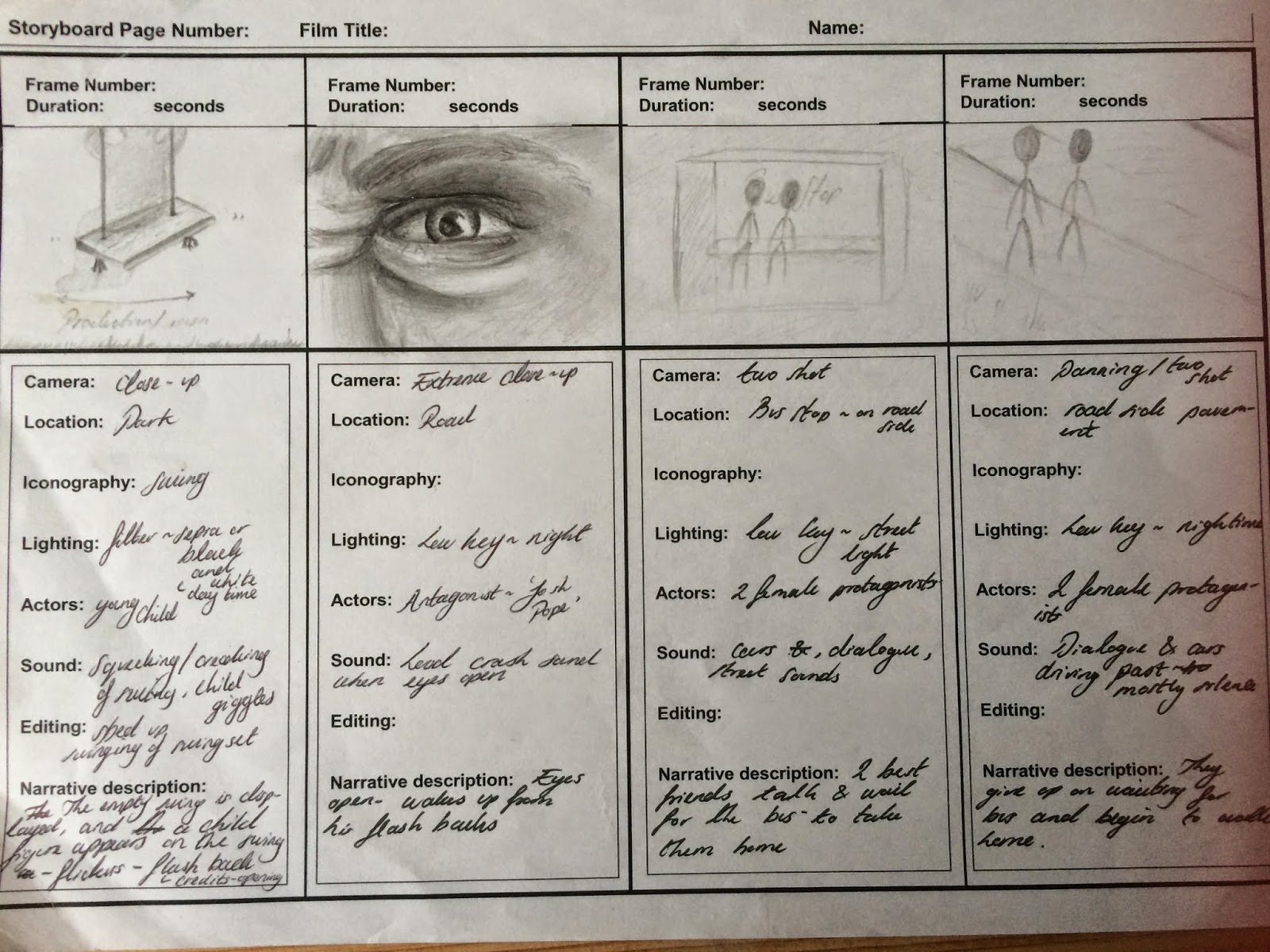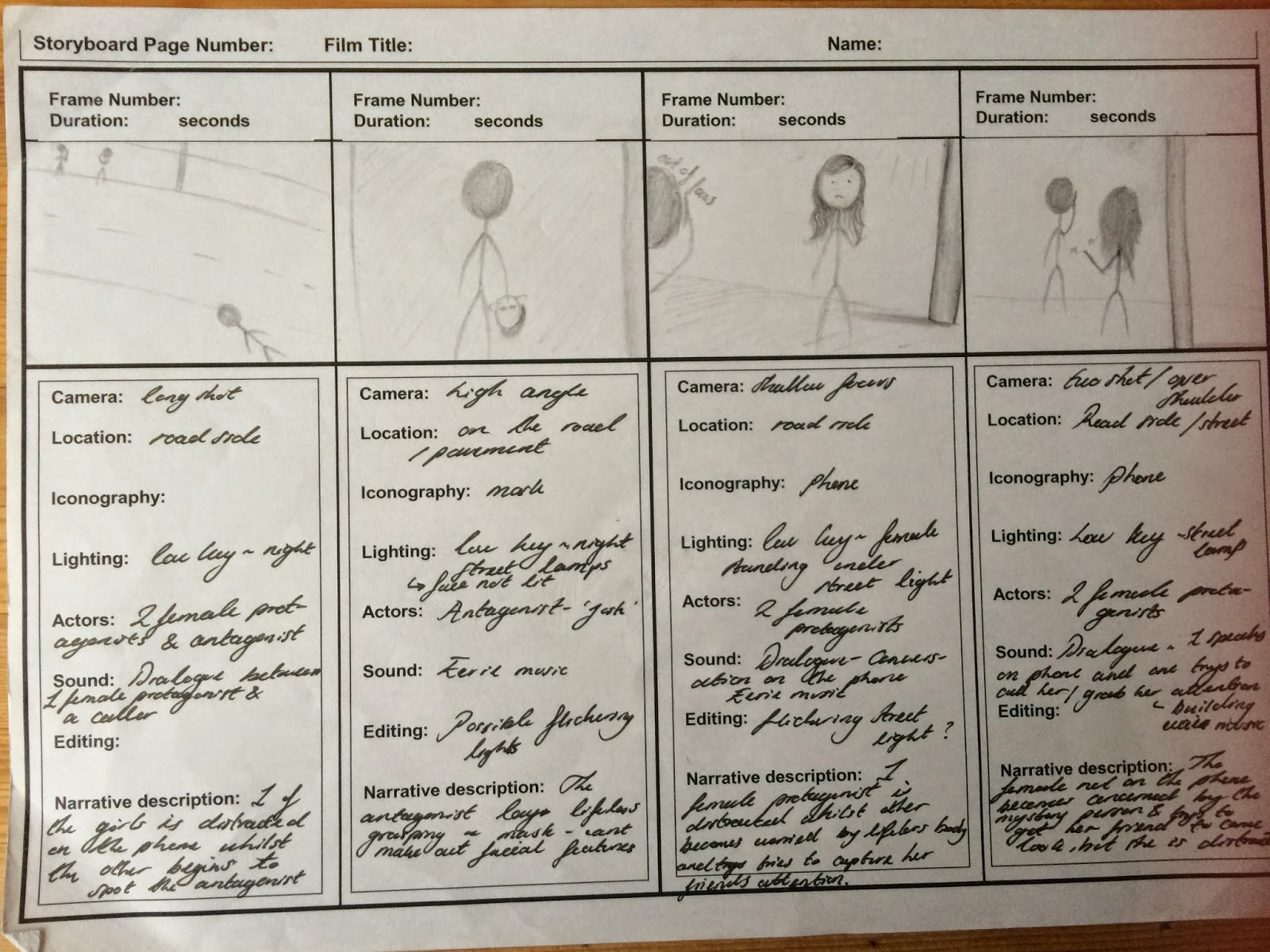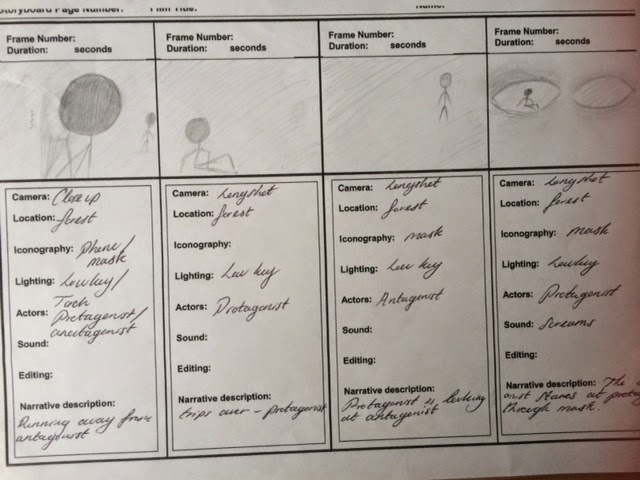Individual Story board
Individual Storyboard- Miss Miller
Story boards are an excellent way to visually identify the specific key points within a piece, such as our thriller film. Each individual section provides an in depth description of each element of mise-en-scene, whether that be, sound, cinematography, iconography, costumes etc. In turn, this provides an extremely good plan to refer back to during myself and my group's filming process.
 |
| Frames 1-4 |
Our thriller film commences with the only scene not filmed with a theme of low key lighting, although conveyed through the use of a black and white filter. Beginning the film in black an white makes the audience question whether the time of the film is set in a time long before the present day or it is unknown. As the audience cant immediately identify the time period they are left with a slight tension, as they they fear the unknown. The scene depicts a vacant swing, moving at a erratic, unnatural rate, suddenly being sat on by the small figure of a saddened young boy. The swing scene later becomes distinguishable as flash back of the antagonist and is dramatically cut short as the antagonist awakes and opens his eyes, shot through an extreme close up. The next two boxes depict the two female protagonists and their struggles they face immediately on their journey home from being out for the night. The introduction of the protagonists in a vulnerable state alert to the audience that they are in a dangerous position, especially as the scene is set at night time. The main aim for 1-4 of my story board is to create a variety of shots in a small space of time providing brief context, as well as presenting a sense of confusion within the audience. The beginning also presents a highly conventional thriller film element, the use of black and white, this is due to its clear connotations of a distinct division of two sides, in most cases within a thriller and this film, good and evil.
.jpeg) |
| Frames 5-8 |
Frame 5 shown, in the image displayed to the right, depicts a panning shot of the protagonist walking in a drunken manner down the road whilst the antagonist is subtly presented. A subtle influence of the antagonist will inform the audience that he has an importance to the narrative without revealing all, providing suspense as the viewer waits to find out what purpose they serve. A very brief high angle of the antagonist laying lifeless in the road will tease the viewer further with the antagonist's presence. 7-8 then go on to present how one of the protagonists have noticed the body and struggle to grasp her friends attention, as she talks on the phone. The lack of attention the protagonist is receiving from her friend presents the theme of separation and increases her vulnerability as she is left by herself, with the strong possibility that she will walk and investigate the mysterious body alone. The suggested tension within amongst the audience will heighten as they anticipate what will happen when she investigates the body alone. The aim of 5-8 is to provide the location and setting for the viewer, as well as displaying the prevalent theme of isolation through the protagonists and the antagonist's body. As well as this, it aims to introduce the foreboding of a danger and evil inflicted upon the protagonists
 |
| Frames 9-12 |
In the frames 9-12, displayed in the image to the left, it shows how the protagonist not on the phone walks away from her friend to analyse the body laying in the road. After the character walks away the audience will only be able to see the character taking through the phone, the conversation will be empty and meaningless to the narrative so the viewer is not distracted by this, solely focused upon what the other protagonist is doing and the reasons why they cannot see her actions. This is immediately followed by the off screen scream and provokes terror in the audience as they soon discover the dead body of the protagonist. I chosen to not include the antagonist in any of these frame to enhance the sense of mystery and confusion for the viewer, as they decipher whether the male character is in fact the murderer. The overall aim of these frames is to further elongate the exit of one of the female protagonists, while introducing her dead body in a dramatically sudden way, thus conveying the conventional viewer responses of surprise and complete shock.
 |
| Frames 13-16 |
The image displayed to the right presents frames 13-16 and the emotion pain inflicted upon the protagonist as she finds her best friend's dead body limp and lifeless, except from when the protagonist abruptly coughs out blood. The antagonist is then suddenly introduced into the scene and confirms to the audience that he is the killer through the severe distress and panic the protagonist offers in response to his presence. The protagonist is then seen desperately running through a forest setting, attempting to loose the antagonist, however, because the setting is so dark, she is forced to switch on her phone torch, making it very easy for the antagonist to locate the character in the depths of the forest. As frame 16 is presented to the audience they are sure to feel a vast amount of built tension and fear for the protagonist, especially as they have already witnessed what the antagonist is supposedly capable of, making the protagonist extremely vulnerable to his intelligent precision and evil mind set. The jerky style of handheld shot, presented when the protagonist is running from the antagonist, heightens tension created by placing the audience in the characters position, providing the illusion they are experiencing all the frantic fear of the character is going currently going through. This camera shot will be paired with diegetic sounds of the protagonist's heavy breathing, as she runs away from her suspected murderer. The heavy breathing empathizes the realism of the scene, meaning although the situation is very extreme, the audience can still relate with it, causing them to be tense, as they have built a relationship with the character, through the point of view shot, and related with the scene. The aim of these frames are to provoke a sudden burst of panic and fear within the audience to mirror what the protagonist is experiencing emotionally, providing an further insight into the mind of the character. This in turn will build a stronger relationship between the audience and the protagonist and provoke an emotionally devoted reaction from the audience during final scenes, making them gripped and suspenseful of what is to happen next.
.JPG) |
| Frames 17-20 |
Frames 17-20 present the final scene of our thriller film. The protagonist is still featured through a point of view shot, with her torch light illuminating the image of her distressed facial expressions. The torch light cast eerie, ghostly shadows upon her face, thus intensifying the tension and fear the viewer is experiencing. As seconds pass and the image of the antagonist becomes a little unfamiliar for the audience, the protagonist trips whilst running through the forest. This immediately increases the protagonist's vulnerability as she may be wounded, as well as not having a logical though process, as she is riddled with terror. Just as the viewer becomes extremely worried for the protagonist, although mildly hopeful as they can not see the antagonist, the antagonist is shown in the distance of a long shot. The long shot provides a very vague but distinguishable image of the antagonist, casting him in the shadow of the forest. The dark shadows make it hard for the audience to view the antagonist and subsequently present the theme of hidden identity. As well as this, the sustained low key lighting, especially exaggerated during this frame, displays connotations of a prevalent evil presence (i.e the antagonist) and a sinister foreshadowing. The final frame is a point of view shot from the antagonist staring at the protagonist as she is paralyzed on the ground with fear. The mild obstruction to the camera lens by the eye hole of the antagonists mask, helps to frame the protagonists character, creating an intense focus upon her, as that is all the audience can see. Also, the clear presence of the mask emphasizes to the viewer that it is in fact the same character, as the one earlier seen laying in the road and perusing the protagonist. A terrifyingly horrific scream from the protagonist works to achieve many things. For example, as the audience are placed in the antagonists point of view they are left feeling some what guilty as they view the female character project a shrill cry as she is in serious danger. The scream also presents a memorable ending as this sound is so high pitched a loud it will lingure in the mind of the audience for a few seconds after the film is ended and has faded to black. This in turn provokes a moving response from the viewer as the protagonists agony refuses to leave them, even when the film is finished. A fade to black I felt was an efficient way to end the film because, it does not remove any attention from the final frame due to its swift transitional ability. In addition the quick and progressive darkness mirrors what the viewer is experiencing, as they are left abruptly in the dark, not knowing what will happen next.
In my personal opinion, I feel as though my individual story board works well, as it is simplistic yet extremely detailed. I have analysed each frame and thought hard about each element of mise-en-scene and how each of these elements, whether is be sound or lighting, create an suitable and convention viewing for an audience. As well as this, I believe there is a balance of cinematography, sound and editing within the story board, making it very easy to create a detail image of the scene, before we have even filmed it. Although it appears seemingly balanced I feel as though I struggled whilst filling in the editing element of each frame, this is predominantly down to my lack of knowledge and experience of editing thus far. Furthermore, when making improvement to my storyboard I would be inclined to add more frames, as although I managed to include mostly all of the action, there were small frames such as, when the protagonist coughs up blood, that I failed to include, as I attempted to compact the film into the agreed number of 20 frames.
My next aim is join with my group, and share a discussion about each of our individual story boards and the advantages and disadvantages of each one. We will then simply hand pick the advantages from each one, and work together to create a group story board. When creating my own storyboard I made sure that I included element we had already agreed upon. For example, the young boy on the swing during the flash back and the extreme close up of the eye. However, I was a little unsure of their thoughts and feelings towards the chase scene and how the protagonist would be clearly seen by the audience. I am therefore excited to see the variety of chase scenes each of our group have created, and how I can adapt my original perception of the ending, to suit the views of my group members.
To conclude, planning my individual storyboard allowed be to branch away from the support of my group and explore my own personal views of our thriller film narrative and artistic direction. It allowed me to analyse what the advantages of my storyboard, as well as the disadvantages, along with how I could improve upon it. Planning also helped me create a greater understanding of our film and the possible challenges we had not first considered, such as the lack of lighting within the dark forest scene. This type of visual aid, although isn't the final group storyboard, still allows me to be more confident during filming, as I can refer back to each frame, and understand what we need to film and capture next, in order to create our idealistic thriller piece. This individual work has also highlighted to me the importance of communication within our group, as we will later come together to discuss each of our ideas, and work together to create something we are all proud of.

.jpeg)


.JPG)
You have provided a very good analysis of your storyboard, explaining the importance of creating one as well as highlighting different elements you have incorporated and how this will help the audience build a relationship.
ReplyDeleteYou need to:
1) Make sure you explain how these features are conventional of the genre
2) Double check spelling and grammar